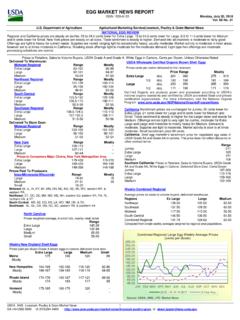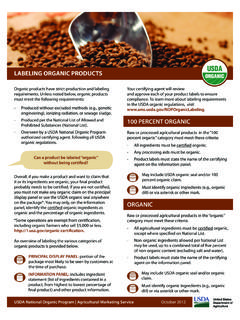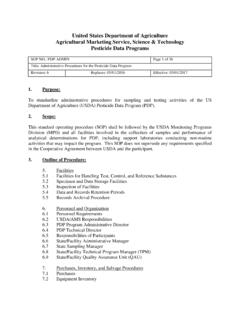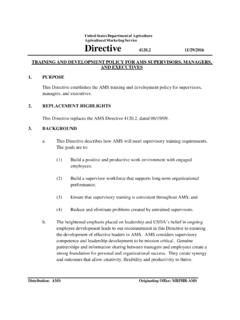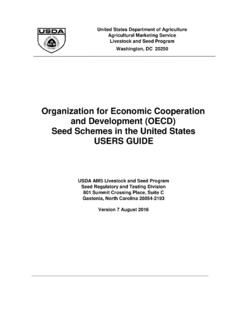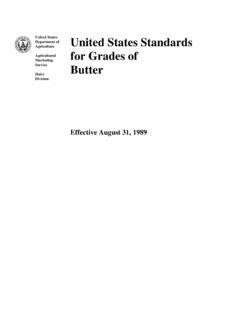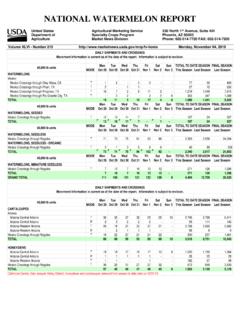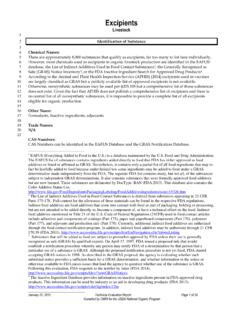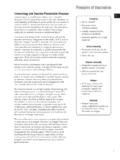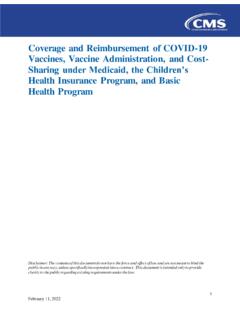Transcription of Vaccines Made from Genetically Modified Organisms
1 Vaccines Made from Genetically Modified Organisms Livestock _____ November 29, 2011 Technical Evaluation Report Page 1 of 17 Compiled by ICF International for the USDA National Organic Program 1 Identification of Petitioned Substance 2 3 Chemical Names: 4 Not applicable 5 6 Other Name: 7 GMO Vaccines , Genetically engineered (GE) 8 Vaccines 9 10 Trade Names: Approximately 13 GMO Vaccines are registered with the USDA/APHIS Center for Veterinary Biologics for use in livestock animals (see Table 1). Individual vaccine trade names are not identified here. CAS Numbers: Not applicable Other Codes: Approximately 13 GMO Vaccines are registered 11 with the USDA/APHIS Center for Veterinary 12 Biologics for use in livestock animals (see Table 13 1).
2 Individual registration codes are not 14 identified. 15 16 Characterization of Petitioned Substance 17 18 Vaccines are administered to livestock species to control infectious diseases, which limit production in 19 animal agriculture and pose disease risk to humans who consume infected animals. Although wild 20 populations are sometimes vaccinated when there is a risk of transmission to humans ( , rabies in wild 21 animals), vaccination is more effective in food animals such as pigs, cows, and poultry. Traditional 22 veterinary vaccination involves injection of an inactivated or live (but weakened so as not to cause disease) 23 bacteria or virus strain in addition to various adjuvants. The vaccine causes the animal s body to create 24 antibodies ( , white blood cells) that are able to recognize bacteria and viruses and kill them, preventing 25 future disease.
3 The creation of antibodies is called humoral immunity. The benefit of live Vaccines is that 26 these Vaccines can also trigger cell-mediated immunity, which is required to fight off viruses and bacteria 27 that are able to get inside of host cells, where humoral immunity is ineffective. 28 29 In recent decades, advancements in immunology, biotechnology, and many other fields have lead to the 30 development of Vaccines produced using genetic engineering technology. Genetic engineering of Vaccines 31 includes the process of deleting, adding, or otherwise Genetically modifying the viral or bacterial organism 32 used for vaccination. These Vaccines include live Genetically Modified Vaccines containing live, weakened 33 strains of the disease; Genetically Modified inactivated or killed Vaccines ; and DNA Vaccines (containing 34 naked DNA).
4 As will be discussed in later sections of this report (see Evaluation Questions #4 and #11, 35 and Additional Questions #5, #6, and #7), genetic engineering has been applied to vaccine development to 36 improve upon traditional Vaccines in a variety of specific ways. In particular, traditional Vaccines have 37 been developed to improve their ability to be tracked in vaccinated animals, reduce viral shedding from 38 animals, increase efficacy against specific diseases, and increase stability during storage and transport. 39 40 Composition of the Substance: 41 42 GMO Vaccines are composed of inactivated or weakened viral or bacterial Organisms that have had genetic 43 material added, deleted, or otherwise Modified . Vaccines may also contain suspending fluids, adjuvants 44 (additives that help stimulate an immune response, most commonly aluminum salts and oil/water mixtures), 45 stabilizers, preservatives, or other substances to improve shelf-life and effectiveness of the vaccine (CDC, 2011).
5 46 Additives in GMO Vaccines do not differ from conventional Vaccines (OIE, 2010). 47 48 Technical Evaluation Report Vaccines Made with Genetically Modified Organisms Livestock November 29, 2011 Page 2 of 17 Properties of the Substance: 49 50 This report concerns Vaccines , which are biological agents with varying physical properties. In general, 51 GMO Vaccines are either live or killed pathogens (viral or bacterial) to which specific modifications, 52 additions, or deletions have been introduced into the pathogen s genome. types of GMO Vaccines are 53 defined further in Additional Question #1 below. 54 55 Specific Uses of the Substance: 56 57 As described above, Vaccines , including GMO Vaccines , are administered to livestock species to control 58 infectious diseases.
6 59 60 Approved Legal Uses of the Substance: 61 62 Under regulations issued by the USDA s National Organic Program (NOP) pursuant to the Organic Food 63 Production Act of 1990, genetic modification is considered an excluded method, which is generally 64 prohibited from organic production and handling under 7 CFR (e). However, the prohibition of 65 excluded methods includes an exception for Vaccines with the condition that the Vaccines are approved in 66 accordance with (a). That is, the Vaccines must be included on the List of Allowed and Prohibited 67 Substances (hereafter referred to as the National List). At present, the National List identifies all Vaccines , 68 as a group, as synthetic substances allowed for use in organic livestock production (7 CFR (a)(4)).
7 69 Vaccines are not individually listed on the National List, but rather are included on as a group of synthetic 70 substances termed Biologics Vaccines , that may be used in organic livestock production (7 CFR 71 (a)(4)). 72 According to livestock health care standards specified in 7 CFR , organic livestock producers must 73 establish and main preventive healthcare practices, including vaccinations. In addition, 7 CFR 74 specifies that any animal drug, other than vaccinations, cannot be administered in the absence of illness. 75 Any animal treated with antibiotics may not be sold, labeled, or represented as an organic ( (c)(7)). 76 Livestock Vaccines are regulated by the USDA s Animal and Plant Health Inspection Service (APHIS) 77 Center for Veterinary Biologics under authority of the Virus-Serum-Toxin Act of 1913.
8 In particular, all 78 Vaccines used in agricultural animals must be licensed, and Vaccines created using biotechnology ( , 79 made with GMOs) must adhere to the same standards for traditional Vaccines . Specifically, vaccine makers 80 are required to submit a Summary Information Format (SIF) specific to the type of vaccine (Roth and 81 Henderson, 2001). A SIF must present information regarding the efficacy, safety, and environmental 82 impact of the vaccine being registered. The purpose of the SIF is to characterize the vaccine s potential for, 83 and likelihood of, risk. Occasionally, peer-review panels are formed to complete risk assessment of 84 Vaccines ; this was the case for the currently licensed live vector rabies vaccine (to reduce rabies in wildlife).
9 85 86 Action of the Substance: 87 88 The action of Vaccines is described in the Characterization of Petitioned Substance section above. Briefly, 89 most Vaccines are injected intramuscularly and once inside the body, cause the immune system to create 90 antibodies ( , white blood cells) that upon subsequent exposure, are able to recognize bacteria and 91 viruses and kill them (humoral immunity). Humoral immunity can be strengthened by cell-mediated 92 immunity, which involves other types of cells ( , natural killer cells ) that are able to fight off viruses 93 and bacteria that enter inside of the animal s cells. 94 95 Combinations of the Substance: 96 97 As stated above, Vaccines may contain suspending fluids, adjuvants, stabilizers, preservatives, or other 98 substances to improve shelf-life and effectiveness of the vaccine (CDC, 2011).
10 In addition, live vector 99 Vaccines (see Additional Question #1 for a definition) contain two different viral strains, providing 100 immunity for two diseases in one vaccine . Other non-vector Vaccines may contain more than one disease 101 strain as well. 102 Technical Evaluation Report Vaccines Made with Genetically Modified Organisms Livestock November 29, 2011 Page 3 of 17 103 Status 104 105 Historic Use: 106 107 Vaccines have been used in humans and animals for several hundreds of years. The first documented use 108 occurred in 1798 when Edward Jenner vaccinated humans with cowpox virus to protect them from 109 smallpox. Vaccines utilizing recombinant gene technology did not appear on the market until the mid-110 1980s.
